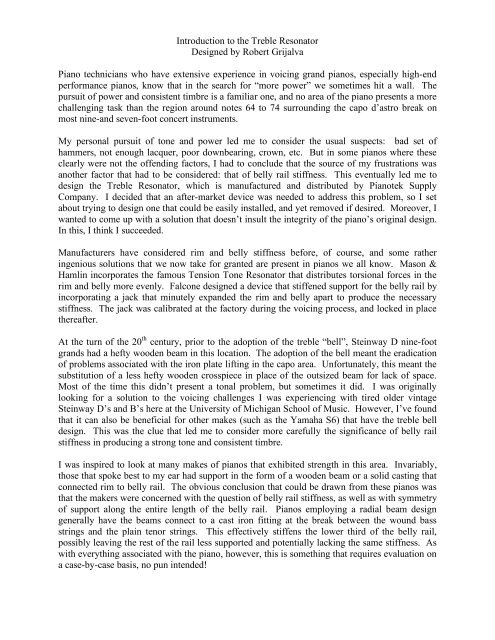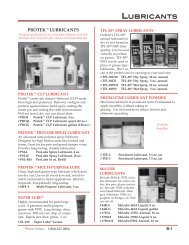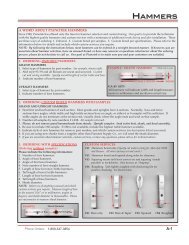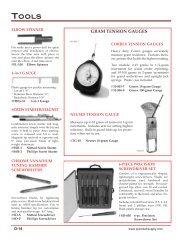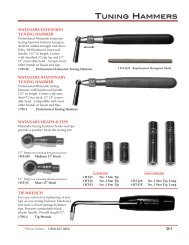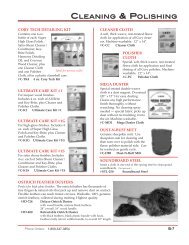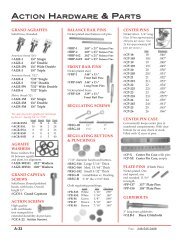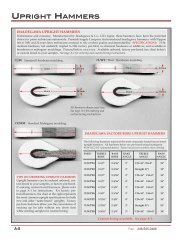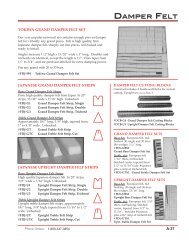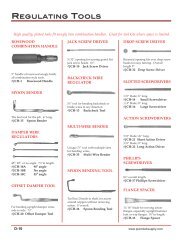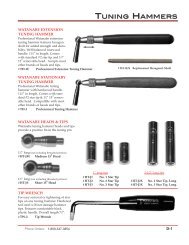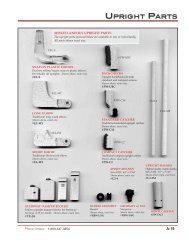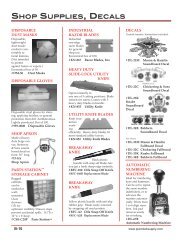Treble Tone Resonator - Pianotek Supply Company
Treble Tone Resonator - Pianotek Supply Company
Treble Tone Resonator - Pianotek Supply Company
- No tags were found...
You also want an ePaper? Increase the reach of your titles
YUMPU automatically turns print PDFs into web optimized ePapers that Google loves.
Introduction to the <strong>Treble</strong> <strong>Resonator</strong>Designed by Robert GrijalvaPiano technicians who have extensive experience in voicing grand pianos, especially high-endperformance pianos, know that in the search for “more power” we sometimes hit a wall. Thepursuit of power and consistent timbre is a familiar one, and no area of the piano presents a morechallenging task than the region around notes 64 to 74 surrounding the capo d’astro break onmost nine-and seven-foot concert instruments.My personal pursuit of tone and power led me to consider the usual suspects: bad set ofhammers, not enough lacquer, poor downbearing, crown, etc. But in some pianos where theseclearly were not the offending factors, I had to conclude that the source of my frustrations wasanother factor that had to be considered: that of belly rail stiffness. This eventually led me todesign the <strong>Treble</strong> <strong>Resonator</strong>, which is manufactured and distributed by <strong>Pianotek</strong> <strong>Supply</strong><strong>Company</strong>. I decided that an after-market device was needed to address this problem, so I setabout trying to design one that could be easily installed, and yet removed if desired. Moreover, Iwanted to come up with a solution that doesn’t insult the integrity of the piano’s original design.In this, I think I succeeded.Manufacturers have considered rim and belly stiffness before, of course, and some ratheringenious solutions that we now take for granted are present in pianos we all know. Mason &Hamlin incorporates the famous Tension <strong>Tone</strong> <strong>Resonator</strong> that distributes torsional forces in therim and belly more evenly. Falcone designed a device that stiffened support for the belly rail byincorporating a jack that minutely expanded the rim and belly apart to produce the necessarystiffness. The jack was calibrated at the factory during the voicing process, and locked in placethereafter.At the turn of the 20 th century, prior to the adoption of the treble “bell”, Steinway D nine-footgrands had a hefty wooden beam in this location. The adoption of the bell meant the eradicationof problems associated with the iron plate lifting in the capo area. Unfortunately, this meant thesubstitution of a less hefty wooden crosspiece in place of the outsized beam for lack of space.Most of the time this didn’t present a tonal problem, but sometimes it did. I was originallylooking for a solution to the voicing challenges I was experiencing with tired older vintageSteinway D’s and B’s here at the University of Michigan School of Music. However, I’ve foundthat it can also be beneficial for other makes (such as the Yamaha S6) that have the treble belldesign. This was the clue that led me to consider more carefully the significance of belly railstiffness in producing a strong tone and consistent timbre.I was inspired to look at many makes of pianos that exhibited strength in this area. Invariably,those that spoke best to my ear had support in the form of a wooden beam or a solid casting thatconnected rim to belly rail. The obvious conclusion that could be drawn from these pianos wasthat the makers were concerned with the question of belly rail stiffness, as well as with symmetryof support along the entire length of the belly rail. Pianos employing a radial beam designgenerally have the beams connect to a cast iron fitting at the break between the wound bassstrings and the plain tenor strings. This effectively stiffens the lower third of the belly rail,possibly leaving the rest of the rail less supported and potentially lacking the same stiffness. Aswith everything associated with the piano, however, this is something that requires evaluation ona case-by-case basis, no pun intended!
The challenge in designing the <strong>Treble</strong> <strong>Resonator</strong> was enabling a connection between the rim andbelly rail that did not interfere with the vertical bolt that extends upwards to the plate from thetreble bell. As mentioned earlier, this vertical bolt is the very reason why pianos of this type donot have a wooden beam at that juncture, leaving a lengthy section of the belly rail unsupported.I also wanted the adjustment to be mechanically intuitive. The <strong>Treble</strong> <strong>Resonator</strong> works bypulling rim and belly toward each other through contraction of the turnbuckle, rather thanexpansion, as in the Falcone jack design. One should rotate the turnbuckle in a clockwisemanner in relation to the plate that is attached to the belly rail. This contraction works toreinforce and integrate the entire system, possibly providing linkage between the belly and therim, enabling them to expand and contract in tandem through seasonal changes, rather than goingtheir own separate ways.I must give credit to fellow technicians Patrick DeBeliso, Dan Harteau, and Bob Marinelli, whourged me on in my design attempts. Special thanks also to Roger Arnett, Sound Engineer here atthe University of Michigan School of Music, who advised me in significant ways aboutprototype development.For my first prototype, I fashioned several three-dimensional models to refine the design, thenmade an actual wooden replica of the contours of the inside rim of the piano, necessary toprovide a true-to-life mold for the prototype. The result was a plate steel weldment with aturnbuckle that, when attached to the rim and belly on a horizontal axis, provided complimentaryand positive reinforcement to that area of the belly rail directly beneath the break between caposections and immediately adjacent to the vertical bolt in the treble bell. Testing was performedon two nine-foot concert instruments at the University of Michigan School of Music. Thesmaller seven-foot version was also tested on School of Music pianos.Pianists who tried the first prototype piano were agreed that the tonal improvement wassignificant. Visiting artists were also surprised at the smooth response across the capo break ofthe pianos in our Recital Hall. Since these initial successes, the <strong>Treble</strong> <strong>Resonator</strong> has beeninstalled onto pianos owned by the Detroit Symphony, Grand Rapids Symphony, and manyprivate clients’ pianos.Successes aside, however, the preceding does not mean to suggest that all radial beam and treblebell-equipped pianos need this kind of reinforcement. It goes without saying that there aremultitudes of pianos with radial beam/treble bell design that have perfectly fine tone, timbre, andpower throughout the range. I was seeking a solution for older pianos in the University’sinventory that exhibited a specific problem that required individual assessment.Does the addition of the treble resonator represent a “redesign” of a piano in which it isinstalled? My answer to that is a firm “no”. It is no more of an alteration to a piano’s designthan adding a screw or dowel where deemed necessary by a rebuilder installing a new pinblockor repairing a joint. It’s simply addressing a perceived weakness in a specific area of the pianowith a piece of added hardware. If needed, it can be removed at any time, and the piano is backto “normal”.
GENERAL INSTALLATION PROCEDUREInstallation of the Grijalva <strong>Treble</strong> <strong>Resonator</strong>Before installing a <strong>Treble</strong> <strong>Resonator</strong>, consult with <strong>Pianotek</strong> for advice on the applicability of thedevice to your piano’s situation. Do not attach the <strong>Treble</strong> <strong>Resonator</strong> to an instrument that hasnot yet been fully voiced and whose need has not been fully established. This is a significantinstallation that, while reversible, requires careful consideration. It requires a well-trained earand substantial expertise in the arena of concert-level voicing. It is not a “quick fix” or “silverbullet” for voicing the treble of any piano. Significant follow-up voicing is required, as it merelyprovides a new platform upon which to build your voicing to a new level.The <strong>Treble</strong> <strong>Resonator</strong> consists of three major pieces: the Weldment that attaches to the S-Curve,the Turnbuckle, and the Belly Plate. Align the entire assembly directly below the last duplex ribof the first capo d’astro section. (This is the string rest cast into the plate between the capod’astro bar and the tuning pins.) This is usually circa notes 66 to 70 on most models of 7-foot or9-foot grands. Placement should be as close as possible to the vertical bolt that connects thetreble bell to the plate. See photos 1 and 2.Photo 1 General Placement
Photo 2 Proximity to <strong>Treble</strong> Bell and vertical boltSince the piano’s rim material is usually hard rock maple or beech, (or a combination ofhardwoods, including mahogany), and the belly may be either birch or pine (depending upon themodel of piano), remember to use the appropriately-sized pilot holes for the supplied lag screwsbased on the type of wood into which you’re drilling. A right angle drill facilitates the drillingprocedure in the tight to reach places.
When drilling the holes into the piano’s rim, it is sometimes helpful to use a square to assist inaligning your drill bit. After establishing the position of the <strong>Treble</strong> <strong>Resonator</strong>, mark the locationof just the first hole for the Weldment end at the S-curve with a center punch or brad point bit.Then, disassemble the <strong>Treble</strong> <strong>Resonator</strong> to facilitate the installation. Once the first hole isdrilled, attach the Weldment end to the rim with the first lag screw. Subsequent holes may bedrilled with the Weldment in place. See photos 3 and 4.Photo 3 Aligning the drill with the use of a machinist square
Photo 4 Weldment situated in the S-Curve for ease of drilling
For drilling in the tightest spots, use a right angle drill. Use whatever variety of lengths of drillbits that enable you to get the job done neatly, and remember to put some masking tape on the bitto use as a depth indicator. The drill pictured here is a Makita right angle drill. It has a verysmall profile and can get into tight spaces well. See photo 5 and 6 for examples.Photo 5 Utilizing an extended length drill bit for the tight spots
Before drilling the Belly Plate holes, remove the Weldment from the S-curve and reassemble the<strong>Treble</strong> <strong>Resonator</strong>. Then, extend the turnbuckle and align it as perpendicular to the belly rail aspossible, so that the Belly Plate is flat on the belly rail. (The Weldment has a reinforced boltwith an extended shoulder that can be bent to achieve better alignment. Only a minor adjustmentshould ever be necessary.) Mark the first hole in the belly rail, drill, and install the first lagscrew before drilling the two remaining holes for the Belly Plate lag screws. Photo 6 illustratesthe use of a shorter bit with the right angle drill. Note the wedge between the bell and theturnbuckle that has been inserted to better align the turnbuckle perpendicular to the belly rail.Photo 6 Drilling the first hole in the belly rail for the Belly Plate
Photos 7 and 8 show the finished installation…Photo 7 Final installation of the Belly Plate lag screws
Photo 8. Completed installation of the <strong>Treble</strong> <strong>Resonator</strong>TONE ADJUSTMENT PROCEDUREFor adjustments, remember to rotate the turnbuckle clockwise in relation to the Belly Plate inorder to contract it. Begin with the turnbuckle in the neutral position. It helps to mark theturnbuckle with white-out or paint to show your starting point. In photo 8, you can see the whitemark on the turnbuckle and bolt at the Weldment end. Tighten in small increments (1/16 th or1/8 th of a turn) until the turnbuckle is just snug, then test the tone for changes. Continuetightening in small increments only until you arrive at the best tonal improvement. Judicioustightening is a must in order to avoid the risk of overtightening and damaging the belly rail.Remember that the goal is simply to stiffen the belly rail, and not to distort it.Total rotation usually doesn’t exceed 1/8 to 1/4 of a turn for best improvement. There is a pointof diminishing returns where additional rotation provides no significant benefit. Discreetlistening skills are required to make this determination. Compare the timbre and tone fromduplex rib to duplex rib in the first capo section and also across the capo break. Usually the lastduplex rib of the first capo d’astro section and the first duplex rib of the second capo d’astroshow the greatest changes (circa notes 62 to 75). Once the correct stiffness is establishedthrough aural testing, set the lock nut.Results from the installation of the <strong>Treble</strong> <strong>Resonator</strong> are typically immediate. In some cases,improvements continue to develop for a period of 24 to 36 hours after installation. However,there is usually no “settling” period, nor need to readjust later. Field tests have shown nosignificant tonal losses over a test period of five years in high-demand concert performancevenues. Once installed and adjusted, there are no maintenance requirements.


